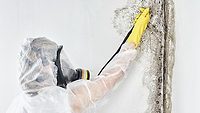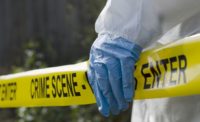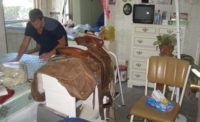Forensic cleaning is quickly becoming a high profit center into which restoration companies are looking to expand. Largely, no doubt, because profit margins range from 85-95%.
Yes that’s right 95%!
Those are some serious numbers, and this is some serious cleaning that takes some serious know-how to get the job done correctly and safely.
Forensic cleaning covers anything that is considered biohazard. But for today, I want to talk to you about cleaning in a particular type of forensic cleaning situation: trauma scene.
A trauma scene is usually the result of one of the following scenarios:
- Unattended death
- Crime
- Suicide
- Accident
Those reasons truly vary by region and area you serve. It has been my experience that the majority of the time, our trauma scene cleaning is due to a suicide.
These types of situations can have a huge emotional and psychological effect on you and your team. You should have a frank and open conversation with yourself as well as your team to determine if this is a right fit for your company. Trauma scene cleaning is not for everyone.
That being said there are basically two major things you need to know: how to do the job correctly, and how to do it safely.
This involves three things:
- Disinfecting
- Odor removal
- Safety for you and your team
I want to stress right up front that you should take a hands-on class and get properly trained by someone who is well versed in the field and with current rules and regulations for this type of cleaning.
Dealing with blood borne pathogens is serious and nothing to fool around with. Once you have the right training, also be sure you have the right insurance and licensing in place on both the state and local levels. Then, you’re ready to get to work.
Disinfecting
Contents needed to be cleaned in situations like this tend to be contaminated by fluid and/or odor. Porous items like clothing that can be thoroughly cleaned using a wet process may be salvageable. However, other items that are porous in nature and cannot be wet cleaned will most likely need to be removed and replaced to properly disinfect the areas involved.
You will want to use a disinfectant that is capable of killing TB (Mycobacterium tuberculosis) because as pathogens go, TB is harder to kill than enveloped and non-enveloped viruses, bacteria and fungi. Be sure you use an EPA-approved cleaner to disinfect on your job site.
Some disinfectants will require different dwell times, so you will want to read the manufacturer’s directions very carefully that come with the product you choose. You may also need to do a pre-cleaning before using your disinfectant product. There are several good brands on the market from which to choose. You will need to do your due diligence and pick the one you are most comfortable working with.
Any items to be salvaged will need to be able to be thoroughly wet cleaned. So most glass, metal and painted surfaces can be cleaned quite easily.
Items like brick, cement and unfinished wood will need to be sealed or painted, generally for disinfecting and and/or odor removal.
Items such as mops, sponges, cotton towels used to clean up and disinfect are disposed of after each job to avoid cross-contamination.
Odor Removal
I have done a lot very smelly fire jobs filled with some seriously strong odor. But there is nothing worse than an unattended death that has gone unnoticed for a week or more in 90 degree weather when it comes to odor.
Removing any contaminated matter and materials is job one here. This will eliminate a lot of the odor right off the bat. You may need to have upholstery and carpeting cleaned throughout the structure or home involved as well to eliminate odor. Laundry items may need to be cleaned even if they are not contaminated due to odor. Cleaning HVAC systems may also be required.
All items that are affected will need to be wet cleaned and/or sealed to eliminate odor. I also use hydroxyl generators on all trauma scene jobs for odor removal. I have found hydroxyl to be more effective than ozone, and less caustic, as well as much safer for animals and humans.
Safety
Personal Protective Equipment (PPE) is crucial for anyone on the job site. My team wears:
- Full face respirators with pathogen filters
- Biohazard Tyvek suits
- Chemical resistant gloves
- Heavy duty rubber boots.
All of our gear is disposable except the rubber boots and full face respirators that we carefully disinfect after every job. Each team member is medically fitted for their own personal full face respirator that is issued only for them to use. I also use duct tape to seal our Tyvek suits at the cuff and ankles so there is no air exchange while in the affected area.
It is vital everyone on your team has received proper vaccinations prior to doing this kind of work. I will say it again: blood borne pathogens are nothing to mess with when it comes to safety.
Caring for Your Team
It’s also a good practice to regularly check in with your team after each job and see how they are doing. Trauma scene cleaning has one of the highest burnout rates in the restoration industry. It’s hard work that affects you in every way.
You may also want to bring in a trauma counselor to talk with your team especially if your company does a lot of these types of jobs.
One final note, you need to consider the fact that some insurance companies may not cover contents cleaning in these scenarios as they may consider this an “act of God” and excludable from coverage.
Trauma scene cleaning is by far one of the most difficult jobs in our industry. Yet for those dedicated companies that perform this work what a service they bring to their communities and this industry.









